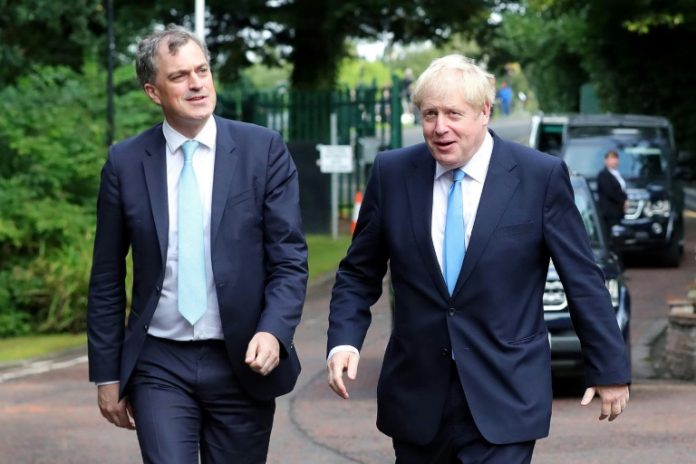British Prime Minister Boris Johnson on Wednesday met leaders in Northern Ireland, the key battleground in Brexit and the focus of increasingly tense rhetoric on both sides of the Irish Sea.
He arrived in Belfast on Tuesday night, amid warnings from Irish leaders that his vow to leave the European Union, with or without a deal, risks breaking up the United Kingdom. Those warnings continued ahead of meetings on Wednesday.
“For everybody across society, Brexit has raised fundamental questions around the wisdom and the sustainability of the partition of our island,” Mary Lou McDonald, the leader of republican party Sinn Fein, told BBC radio.
“In the event of a hard Brexit and a crash Brexit, I don’t know for the life of me how anybody could sustain an argument that things remain the same.”
Johnson will hold talks with Northern Ireland’s main political parties to discuss the restoration of the British province’s power-sharing government, which collapsed in January 2017.
“My prime focus this morning is to do everything I can to help that get up and running again,” Johnson told Sky News television ahead of meetings. But Brexit will dominate the visit.

The Republic of Ireland shares a land border with the province that both sides want to keep free-flowing after Brexit, both for economic reasons and to maintain the delicate peace deal that brought an end to decades of violence between the Irish and British communities.
But post-Brexit, that border will become part of the EU’s external frontier and would legally require policing.
The agreement struck by Johnson’s predecessor Theresa May proposed the so-called “backstop” solution to preserve the EU’s single market and prevent a hard border on the island.
But eurosceptics believe it gives the EU too much control over the UK and risks constitutionally distancing Northern Ireland from Britain.
If a trade deal cannot be agreed by the end of 2020, under the backstop the UK would remain aligned with the EU customs union, while Northern Ireland would further stay aligned to some European single market rules, in order to keep the Irish border free-flowing.
Neither London nor Brussels can end the arrangement unilaterally.
“The way to deal with the backstop is to find a different way of dealing with the relationship between the United Kingdom and the Republic of Ireland moving forward,” Arlene Foster, the leader of Northern Ireland’s pro-British Democratic Unionist Party told broadcaster RTE.
“It’s certainly not to deal with it in a way that breaks up the United Kingdom.”
On Tuesday Johnson told Irish Prime Minister Leo Varadkar that the “backstop” plan was unacceptable, putting him at odds with both Dublin and Brussels, which insist the deal is not open for renegotiation.
“If they really can’t do it then clearly we have to get ready for a no-deal exit,” Johnson said on a trip to Wales, adding: “It’s up to the EU: this is their call.”
Meanwhile Varadkar has said that Johnson’s plan to renegotiate the deal by a deadline of October 31 was “totally not in the real world”.
Leaving without a deal would throw the border status into confusion and threaten economic catastrophe for Ireland, cutting it off from its UK main trading partner.
But Johnson pledged to Varadkar on Tuesday there would be no physical checks on the border, whatever happened.
Varadkar also said on Friday that a no-deal Brexit would make the unification of Northern Ireland and the Republic of Ireland more likely.
“People who you might describe as moderate nationalists or moderate Catholics who were more or less happy with the status quo will look more towards a united Ireland,” he said.
Northern Ireland is not the only country whose status as a member of the UK after Brexit is under the spotlight.
Johnson visited Scotland on Monday, where First Minister Nicola Sturgeon said last week that Scotland needed an “alternative option” to Johnson’s Brexit strategy.
He also visited Wales on Tuesday as part of the whistlestop tour of the UK, designed to signal his commitment to keeping the union whole after Brexit.












